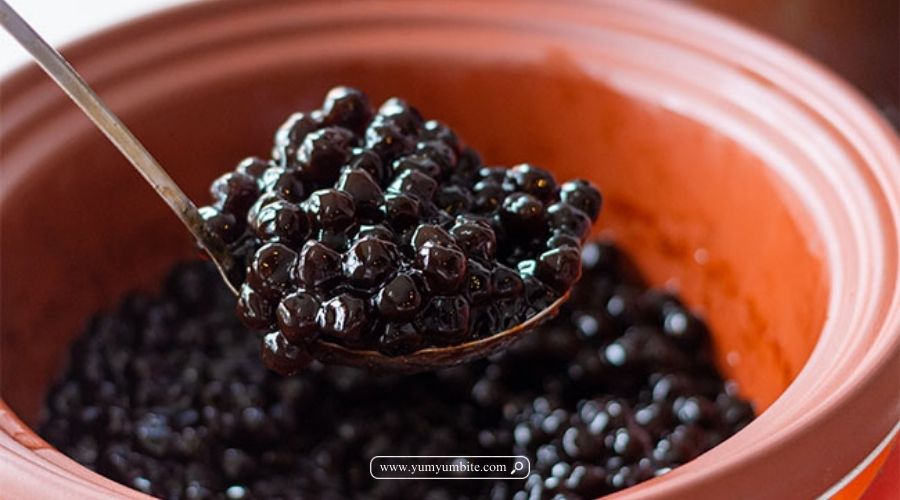Boba, the beloved chewy pearls often found in bubble tea, are a delightful treat that can elevate your beverage experience.
However, if you find yourself with leftover cooked boba, knowing how to store it properly is crucial for maintaining its unique texture and flavor.
Improper storage can lead to hard, unappetizing pearls or overly mushy textures, diminishing the joy of enjoying your bubble tea.
In this guide, we’ll explore the best practices for storing cooked boba, ensuring you can savor its delightful chewiness whenever you desire.
Why Storing Cooked Boba Properly Matters
Storing cooked boba properly is essential for maintaining its unique texture and flavor.
Boba, or tapioca pearls, are prized for their chewy consistency, which can quickly diminish if not stored correctly.
When exposed to air or stored improperly, cooked boba can harden or become overly mushy, ruining the delightful experience that comes with enjoying a bubble tea.
Proper storage techniques not only extend the shelf life of cooked boba but also preserve its freshness, ensuring that each bite remains enjoyable.
Additionally, understanding the right methods for storing boba helps prevent waste, allowing you to savor your homemade bubble tea creations without compromising quality.
Whether you’re preparing a batch in advance or saving leftovers, effective storage practices are key to enjoying boba at its best.
Complete Guide on How to Store Cooked Boba

Storing cooked boba correctly is crucial for maintaining its chewy texture and flavor.
Here’s a comprehensive guide to ensure your boba stays fresh and enjoyable.
1. Cool the Boba
After cooking the boba, allow it to cool to room temperature. This step is essential as placing hot boba directly into storage can create moisture, leading to undesirable texture changes.
2. Choose the Right Container
Use an airtight container to store your cooked boba. Glass or BPA-free plastic containers are excellent choices because they prevent air exposure and keep the boba from drying out.
If you don’t have an airtight container, a sealable plastic bag can work as well, but be sure to remove as much air as possible before sealing.
3. Add a Sweetener or Syrup
To help maintain the boba’s texture and prevent it from becoming sticky, consider adding a small amount of simple syrup or honey to the container.
This coating helps keep the pearls moist and flavorful.
4. Refrigeration for Short-Term Storage
If you plan to use the cooked boba within a day or two, store it in the refrigerator. Properly stored, it can last about 1 to 2 days.
Keep in mind that refrigeration can change the texture slightly, so it’s best to consume it as soon as possible.
5. Freezing for Long-Term Storage
For longer-term storage, freezing is the best option. Spread the cooled boba in a single layer on a baking sheet and freeze until solid.
Once frozen, transfer the Boba to an airtight freezer-safe container or a heavy-duty freezer bag.
This method helps prevent the pearls from clumping together and allows you to take out only what you need.
6. Thawing and Reheating
When you’re ready to enjoy your frozen Boba, remove the desired amount from the freezer and let it thaw in the refrigerator for a few hours.
To restore its texture, briefly boil the thawed boba in water for about 1-2 minutes. This step helps rejuvenate the chewiness, bringing the boba back to its original state.
7. Check for Freshness
Before consuming stored boba, inspect it for any signs of spoilage, such as off smells or unusual textures. If anything seems amiss, it’s best to discard it.
By following these guidelines, you can ensure that your cooked boba remains delicious and enjoyable, ready to complement your favorite bubble tea or dessert recipes whenever you desire.
Proper storage not only enhances your culinary experience but also helps reduce waste, allowing you to savor the delightful chewiness of boba for longer.
What to Look for While Storing Cooked Boba
When storing cooked boba, several key factors are important to ensure its freshness and quality.
First, it’s essential to let the boba cool to room temperature before placing it in any storage container. This helps prevent condensation, which can lead to sogginess.
Next, choose an airtight container to keep out air and moisture, as exposure can affect the boba’s texture. Glass or BPA-free plastic containers are ideal for this purpose.
If using a bag, ensure it’s sealable and remove as much air as possible.
Consider the duration of storage; for short-term use, refrigeration is suitable, while freezing is the best option for longer storage.
Boba can last up to 1-2 days in the fridge, but for extended freshness, freezing is recommended.
Lastly, when storing, you may want to add a small amount of syrup or honey to help maintain moisture and prevent stickiness.
By being mindful of these factors, you can effectively store cooked boba and enjoy its delightful texture and flavor for days to come.
How to Choose the Right Accessories for Storing Cooked Boba

Selecting the right accessories for storing cooked boba is essential for preserving its unique texture and flavor.
Here are some considerations to help you make the best choices:
1. Airtight Containers
Invest in high-quality airtight containers made of glass or BPA-free plastic.
These containers are ideal for keeping out air and moisture, preventing the boba from drying out or becoming too sticky.
Choose a size that fits the amount of boba you have to minimize excess air in the container.
2. Sealability
If you prefer using bags for storage, opt for sealable plastic bags designed for food storage.
Look for heavy-duty options that can withstand freezing and help protect the boba from freezer burn.
When using bags, make sure to remove as much air as possible before sealing to maintain freshness.
3. Parchment Paper
When freezing cooked boba, consider using parchment paper. Spread the boba in a single layer on a baking sheet lined with parchment paper before freezing.
This method prevents the pearls from clumping together and makes it easier to portion out the desired amount later.
4. Labels and Markers
Use labels and a permanent marker to keep track of storage dates. Clearly marking the date on your containers or bags helps ensure you consume the boba while it’s still fresh, reducing the risk of spoilage.
5. Syrup or Sweeteners
Having a small container of simple syrup or honey on hand can be useful.
Adding a bit of sweetener to your storage container helps keep the boba moist and flavorful, enhancing your overall bubble tea experience.
By choosing the right accessories, you can effectively store cooked boba, ensuring it stays fresh and enjoyable for your bubble tea creations.
Proper storage not only enhances the quality of your boba but also helps you get the most out of your culinary endeavors.
How to Tell If Cooked Boba Is Bad After Storing
Determining whether cooked boba is still good to eat is essential for ensuring food safety and maintaining the quality of your bubble tea experience.
Here are key signs to look for:
1. Smell
One of the first indicators of spoilage is the smell. Fresh boba should have a neutral, slightly sweet aroma.
If you notice a sour or off smell, it’s a clear sign that the boba has gone bad and should be discarded.
2. Texture
Examine the texture of the boba. When fresh, cooked boba is chewy and slightly firm. If the pearls feel excessively hard, mushy, or slimy, this indicates spoilage.
Boba that has lost its signature chewiness is no longer enjoyable and should be thrown away.
3. Appearance
Check for any visible signs of mold or discoloration. Fresh boba should have a uniform, translucent appearance.
If you see any dark spots, unusual colors, or signs of mold, it’s best to discard the boba immediately.
4. Taste
If the boba looks and smells fine but you’re still uncertain, consider tasting a small piece. If it tastes off, sour, or stale, it’s safer to discard it rather than risk consuming spoiled food.
5. Storage Duration
Keep track of how long the boba has been stored. Cooked boba is best consumed within 1-2 days when refrigerated.
If it has been stored longer than recommended, even if it appears fine, it’s better to err on the side of caution and dispose of it.
By being vigilant and checking for these signs, you can ensure that your stored cooked boba remains safe and enjoyable to eat.
When in doubt, it’s always best to prioritize safety over risk!
1. How long can I store cooked boba in the refrigerator?
Cooked boba can be stored in the refrigerator for up to 1-2 days. It’s best to consume it within this timeframe for optimal freshness and texture.
2. Can I freeze cooked boba?
Yes, you can freeze cooked boba for long-term storage.
Spread the boba in a single layer on a baking sheet, freeze until solid, and then transfer to an airtight freezer-safe container or bag. It can last for up to 3 months in the freezer.
3. How do I reheat stored boba?
To reheat stored boba, bring a pot of water to a boil and add the boba. Boil for 1-2 minutes until heated through. This helps restore its chewy texture.
4. What’s the best way to store leftover cooked boba?
Store leftover cooked boba in an airtight container, ideally with a little simple syrup or honey to help maintain moisture.
Keep it in the refrigerator for short-term storage or freeze for long-term use.
5. How can I tell if cooked boba has gone bad?
Check for signs of spoilage, such as off smells, unusual textures (hard, mushy, or slimy), or visible mold. If in doubt, it’s safer to discard it.
6. Should I store boba in the same container as my bubble tea?
It’s best to store cooked boba separately from your bubble tea to maintain its texture. When ready to enjoy, you can add the boba to your drink.
7. Can I store cooked boba in plastic bags?
Yes, you can use sealable plastic bags for storing cooked boba. Just ensure to remove as much air as possible before sealing to prevent moisture loss and maintain freshness.
Conclusion
Storing cooked boba correctly is essential for preserving its delicious texture and flavor, allowing you to enjoy it at its best for days to come.
By following the right techniques—such as cooling the boba before storage, using airtight containers, and choosing appropriate methods for refrigeration or freezing—you can extend the shelf life of your boba without compromising quality.
Whether you’re preparing a refreshing bubble tea or experimenting with desserts, these storage tips will help you get the most out of your cooked boba, ensuring every sip is a delightful experience.
References
- https://www.foodnetwork.com/how-to/packages/food-network-essentials/tapioca-pearls
- https://www.hungryhuy.com/how-to-cook-tapioca-pearls/
- https://www.instructables.com/Re-heat-Tapioca-Pearls/
- https://www.angelwongskitchen.com/how-to-cook-boba-bubble-tea-pearls.html
- https://abeautifulmess.com/how-to-prepare-boba-pearls-at-home/


